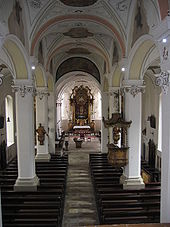Marienkirche (Ellwangen)
The Marienkirche in the center of Ellwangen is a Catholic church that was built in 1427 as a town church for the parish of Ellwangen and today belongs to the parish of St. Vitus .
history
Predecessor buildings of the Marienkirche
The early history of the Marienkirche lies largely in the dark, there are only indications that the Marienkirche initially stood in the area of Priestergasse and was only later moved to its current location. What is certain is that the (early) St. Mary's Church had already lost all independence in 1259, that is , was incorporated into the Benedictine monastery in Ellwangen . It is also difficult to give an exact date of consecration; there are no more records of any earlier consecrations. On the basis of a parchment that was found in the castle museum, it is certain that the church was consecrated on July 7, 1398 (the first Friday after Corpus Christi) by the titular bishop of Sebaste. It is probably about the Carmelite Ulrich, who can be documented as auxiliary bishop in Augsburg for the year 1404 .
Construction of the Marienkirche
The start of construction of the Marienkirche is given as 1427, builder is probably the Abbot Johann von Holzingen. In the years that followed, numerous construction work took place, for example a new altar was added in 1447. After major renovations (1487-1492) in which the entire structure were renewed including the altars, the church around the Michaelmas (29 September) of the year 1493 was again by a bishop from Adramytteum consecrated . Since the consecration ceremony was very extensive and lasted several days, it is not possible to give an exact date of the consecration of the church building. However, it is certain that the altars were consecrated on September 29, 1493. Today the year 1493 is given as the consecration date.
Changes in the following years
The church construction was changed again and again in the following centuries: For example, the interior of the church, which was originally built in Gothic style, was changed to Baroque in 1753. Mostly inferior building material was used, which can still be seen today on the exterior facade.
Until 1818, the Marienkirche served as the second parish church in Ellwang, alongside the collegiate basilica of St. Vitus. It included the entire town of Ellwangen and some surrounding farms and hamlets. Since the Marienkirche was no longer independent since 1259, the fortunes of the parish were directed by the monastery or monastery, that is, monastery and collegiate priests and later in the 18th century the Jesuits worked as pastors. Although they carried the title of pleban or pastor, in reality they were only perpetual vicars with modest salaries. After the prince provost of Ellwangen became part of Württemberg, the Marienpfarrei was merged with the monastery parish in 1818.
Renovation work in the 21st century
From 1993 to 2004 extensive renovation work was carried out on the tower and the facade. Even in this construction phase, strong cracks in the vaulted ceiling and the ceiling paintings were found in the interior, which made further security measures in the interior unavoidable. For this purpose, the church had to be completely closed between 2004 and 2007. On the feast of the Assumption of the Virgin Mary was reopened on August 15, 2007.
description
With its 40 meter high freestanding tower, the Marienkirche is one of the landmarks of downtown Ellwangen that can be seen from afar, along with the St. Vitus Basilica.
inner space
Ceiling paintings by Edmund Widemann adorn the nave. Particularly striking are the silver altar and the Madonna, which the Ellwang citizen Ignaz Emer created in the church choir in 1748. On the sides of the chancel are the carved choir stalls, which are reserved for the members of the Rosary Society. The prince-provost builder Arnold Friedrich Prahl, who redesigned the Marienkirche in 1753, is buried in the church.
Peal
The ringing of the Marienkirche consists of four bells. The largest bell was cast in 1899, another in 1908. The youngest bell is the Marienbell, donated by the Rosary Brotherhood in 1961.
organ
The Marienkirche has an organ controlled by a mechanical cone shutter. It is built around a window, below the window is the wind supply, as well as the gaming table aligned in the chancel, to the left and right of it are the 3 divisions main plant, pedal plant and substation, divided into c- and cis- drawer. The substation is behind the case wall at the level of the console, above, at the level of the zinc pipes seen in the prospectus, the main work, and behind it the pedal work. The organ has 18 sounding registers, a tremulant that can be assigned to both manual works and can be regulated by potentiometer, as well as manual and pedal couplings, and three fixed combinations: flute choir, pleno, and tutti
The disposition of the organ:
|
|
|
||||||||||||||||||||||||||||||||||||||||||||||||||||||||||||||||||||||||||||||||||
Todays use
Masses are usually only held in the Marienkirche on Marian feasts. The Marienkirche is regularly used for the Taizé prayer, which takes place every Friday evening, and the church also regularly hosts the student services of the St. Gertrudis girls' secondary school. The Marienkirche is also used by the parish of St. Vitus for requiums and rosaries and weddings.
View from the tower of the Marienkirche over the city to the Basilica of St. Vitus
Web links
Coordinates: 48 ° 57 '34.8 " N , 10 ° 7' 55.9" E





